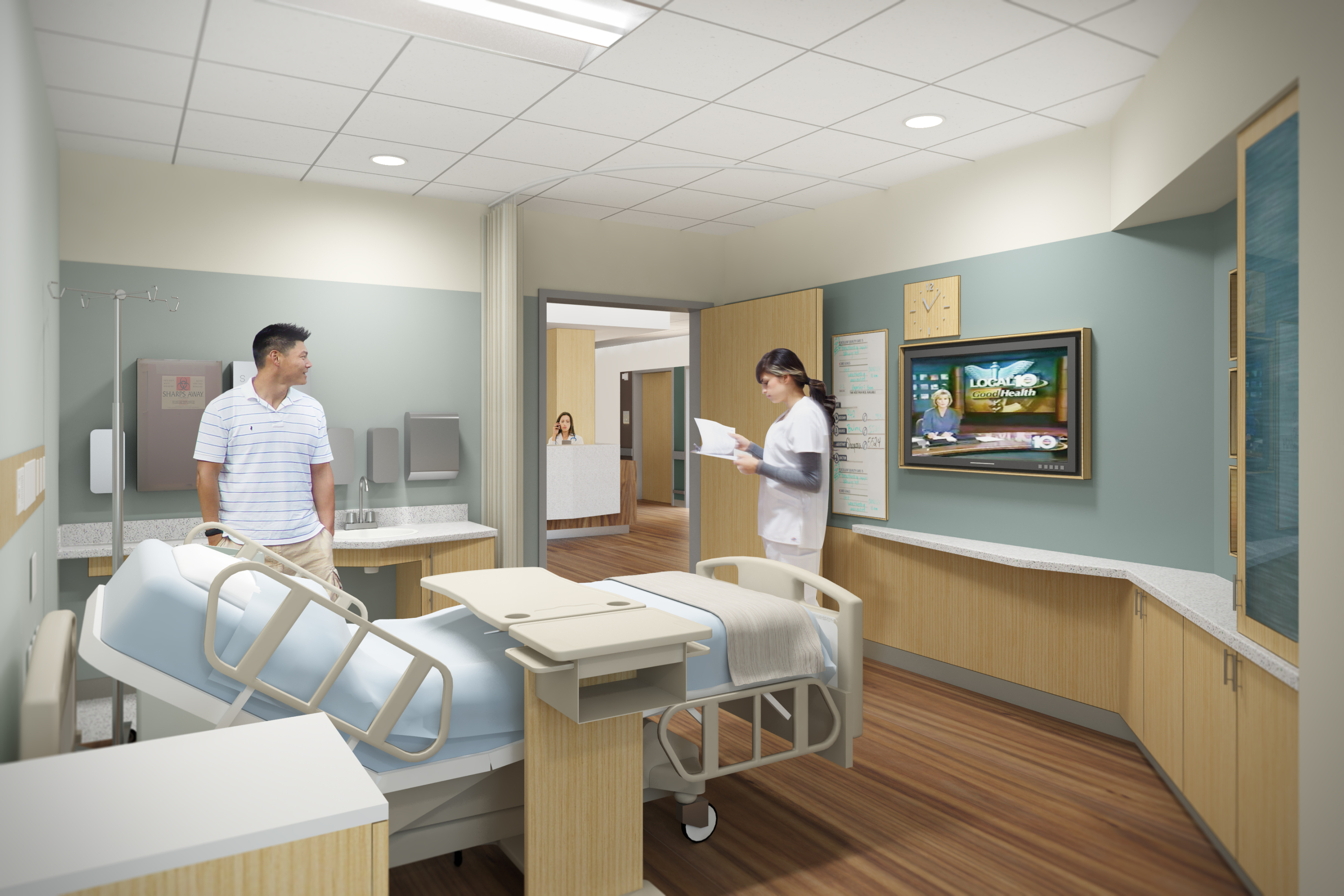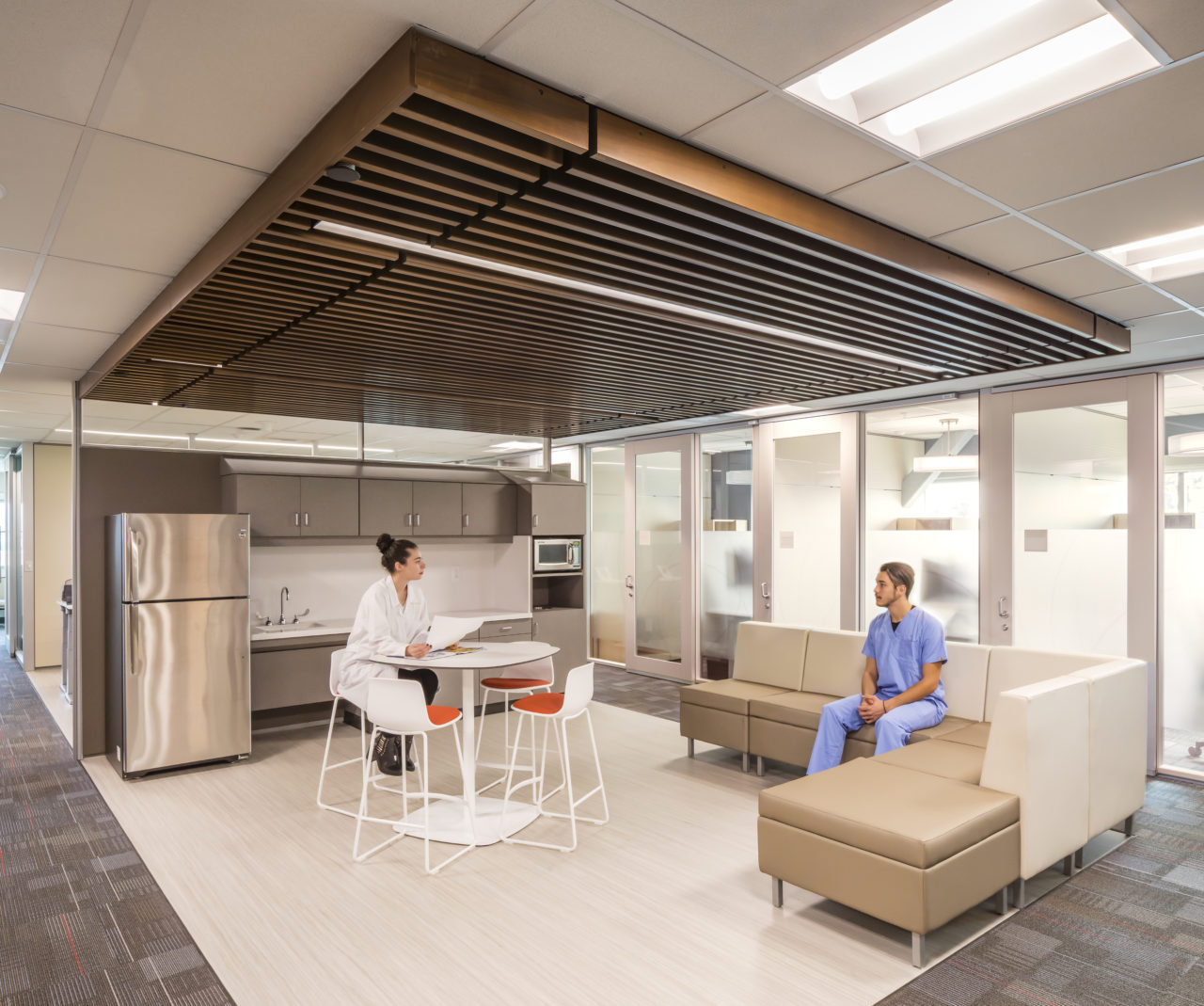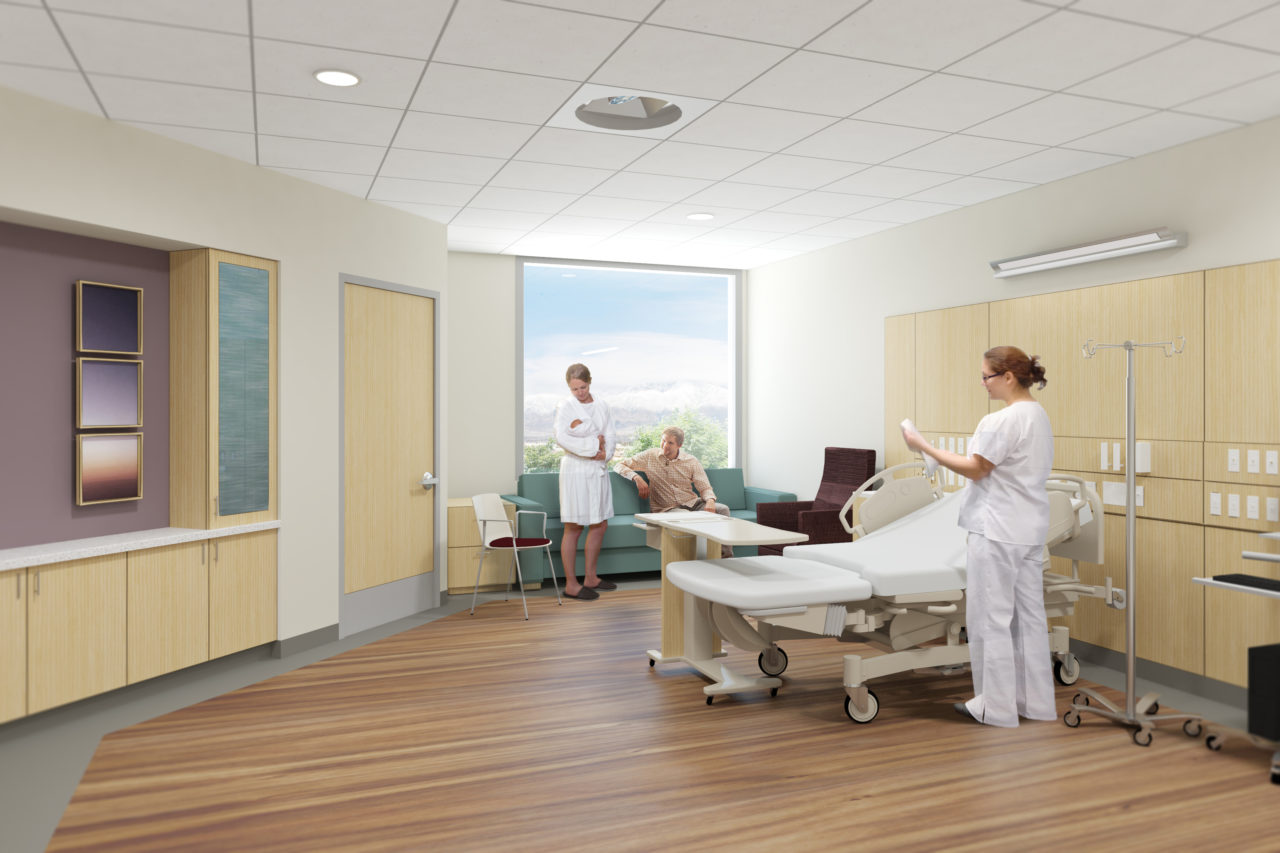Hospital room design has a significant impact on patient care and recovery outcomes. Patients rely on staff to respond to emergency situations quickly, check in on them frequently, and ensure a full recovery. However, staff can only treat patients effectively when they can perform their tasks efficiently and have equipment and supplies that are easily accessible. By partnering with an architectural firm to design hospital rooms around staff workflows and make those spaces as comfortable as possible for patients and their visitors, hospital administrators can assure the highest level of care.
Hospital Room Design Challenges Architects Must Overcome
One of the greatest challenges that architects face when designing a hospital room is the need to accommodate three very different functions in the space. First, the room has to be comfortable and calming for the patient. Second, caregivers must be able to navigate the space quickly and efficiently. And finally, family and other visitors must have an area in which they can sit or sleep comfortably without disrupting attending staff workflow or the patient’s recovery. In a small hospital room, this is a serious challenge, as space is extremely limited.
Another challenge of hospital room design is providing clear lines of sight from the nurses’ station. Efficient hospital room design should also be adaptable, which can add an extra layer of complexity to the design process because every patient has different needs.
Architects have discovered innovative ways to meet these challenges and create efficient hospital rooms that support patients, staff, and visitors. By focusing on details such as equipment placement, flexible furniture, acoustics, and lighting, architects can dramatically improve staff efficiency and effectiveness.
Hospital Room Design Features That Foster Greater Efficiency
To create the most efficient hospital room design strategy, architects thoroughly research staff and patient needs in advance. By leading eco-charrettes, researching scientific studies, analyzing hospital-provided data, and following evidence-based design principles, HMC Architects has developed strategies for hospital room designs that can help staff perform their daily tasks more easily, while at the same time allowing for great patient and family experiences in the hospital. These strategies include the following:
Clear Lines of Sight
The following design concepts help nurses observe all patients:
- Room Layout. U and C patient room configurations work best in ICUs, as they better allow staff to observe and quickly access every patient room from a central station.
- Cockpit Stations. For large Nursing Units where nurses’ stations are located far apart, architects design smaller, decentralized “cockpit” nurses’ stations in between groups of two rooms, allowing for direct observation of the patient.
- Glazed Doors. Doors with glass panel windows allow staff visibility into patient rooms.
Improving the line of sight to hospital rooms is a best practice that architects prioritize to streamline staff workflows and offer excellent patient care.
Easily Accessible Supply and Equipment Locations
The placement of necessary tools and equipment also has an impact on staff efficiency. As such, architects consider:
- Lower Cabinet and Equipment Placement. When we designed Henderson Hospital in Nevada, we learned that some nurses had trouble reaching the top shelves in patient rooms and supply closets. So, we placed essential equipment and supplies lower in storage rooms to accommodate them.
- Supply Storage Where It’s Needed. Small supply drawers built into the patient room corridor wall can offer staff the supplies they need on-demand.
- Ceiling-Integrated Equipment. Supporting medical equipment like patient lifts and IV poles from the ceiling opens up floor space, allowing staff to move through the room more efficiently.
- Supporting Mobile Equipment for Care On-the-Go. A study published by JMIR Human Factors in 2017 found that more than 20 percent of nurses use their personal mobile devices to access important work-related medical information. By embedding outlets into furniture and offering more outlets, or USB charging stations in walls and on countertops, nurses and other staff members can keep their devices fully-charged at all times.
By placing supplies and tools within easier reach, staff can perform tasks much faster and more efficiently.
Room Layout and Furniture Placement
Furnishings in patient rooms are required for patient and visitor comfort, but they can also disrupt staff workflow. To cause the least disruption, room layout should be maximized, or right-sized. To create a more efficient hospital room design, architects can:
- Divide the Room into Three Zones: The staff zone should be at the entrance to the room to foster efficiency in performing their tasks, while providing the least impact on occupants. Patient amenities should be placed at the center of the room, and at the back of the room, place comfortable seating for visitors.
- Use Lightweight or Wheeled Furniture: Wheeled furniture and lightweight, modular ottomans can be quickly moved out of the way in an emergency. A sofa that can expand into a bed will serve a dual purpose.
- Design Bathrooms Based on Need: Front-located bathrooms leave room for a larger visitor area in the back of the room but may limit visibility to the patient. Rear-located bathrooms provide improved sight lines to the patient but sacrifice family space and expansive exterior views out of the room. Center-bar bathrooms represent a compromise between the front and back bathroom options, allowing both maximum visibility into the room and unobstructed views to the outside.
These patient room details allow architects to design with the patient experience in mind while also providing clear pathways for staff.
Room Flexibility
If a hospital doesn’t have enough rooms to accommodate patients and the treatments they need, active and latent failures can occur. A 2017 joint study by Ariadne Labs and MASS Design Group found that Caesarean deliveries are more common in hospitals that have fewer dedicated labor rooms and a greater number of operating rooms. The study suggests that doctors are less likely to choose specific treatment plans if the hospital lacks the resources to support them—even when those treatment plans are the best options for patients.
To reduce the chances of this occurring, architects create acuity-adaptable rooms that are designed to accommodate various types and levels of care. For example, in an Obstetrics Unit, patient rooms can be specifically designed for delivery, short-term surgical recovery, and antepartum care. Flexible furniture and wheeled equipment make these rooms adaptable to more situations. Moreover, patients won’t have to be transferred to other locations for treatment as often.
Acuity-adaptable Nursing Units can manage different levels of care if the room is right-sized for the most intensive use. As hospitals must manage varying occupancy rates and acuity levels, strategies that allow for Nursing Units to “flex” are in good part driven by bed room sizes.
Lighting, Ventilation, and Acoustics
Patients and staff need plenty of light and healthy ventilation. Nurses’ stations can often get loud, which can be distracting for patients. To solve these challenges, architects focus on the following features:
- Varied Lighting: The highest lighting levels are at the entrance to a patient room, where caregivers perform their tasks, as well as at nurse stations. Implementing dimming features and night lighting on the orange-red spectrum can reduce the risk of patient disruption while they’re trying to sleep.
- Quiet HVAC System: A super sound-insulating HVAC system or a white noise sound-masking system can reduce noise levels in rooms located near high traffic work areas.
- Ventilation for Comfort: Good ventilation improves patient and staff comfort, as well as patient health outcomes.
By considering all of these design details, architects can create a hospital room that fully supports the staff’s efforts while also offering a calm place for patients to recover.
Efficient Hospital Room Design Benefits Staff and Patients Alike
Hospital rooms should be safe spaces in which patients feel well cared for and staff can easily provide treatment. These design details not only streamline staff workflows but can also help improve patient recovery rates and lead to higher patient satisfaction. This, in turn, may even result in increased revenue at your facility—the Centers for Medicare & Medicaid Services reimburse hospitals for up to 2% of the total cost of treatment if a patient’s satisfaction rating is high.
When you partner with an experienced architecture firm that understands the needs of patients and staff, as well as the room design features that patients find calming, you can create a responsive healthcare facility that exceeds everyone’s highest expectations.
For more information about hospital room design strategies, contact HMC Architects today. Our team of experienced architects creates efficient patient rooms that are designed to improve staff workflows and help your healthcare facility run as smoothly as possible. If you have specific questions about our healthcare facility design process, email Christopher Naughton, AIA, ACHA Senior Healthcare Planner, directly.





